Collection of materials relating to neuro-ophthalmology as part of the Neuro-Ophthalmology Virtual Education Library.
NOVEL: https://novel.utah.edu/
TO
1 - 25 of 20
| Title | Creator | Description | Subject | ||
|---|---|---|---|---|---|
| 1 |
 | Illustrations of the Afferent Visual Pathway and Concepts Surrounding Trans-Synaptic Neuroaxonal Degeneration in the Visual Pathway in Multiple Sclerosis | Olwen C. Murphy; Peter A. Calabresi; Shiv Saidha | Image 1 title: Functionally-eloquent organization of the afferent visual pathway; Image 1 description: The afferent visual pathway is a sensory pathway comprised of 3 neurons. The 1st order neurons are the shortest neurons in the pathway and are entirely unmyelinated. The cell bodies of the 1st orde... | Optic Neuritis; Multiple Sclerosis; Neuroaxonal Degeneration; Trans-synaptic Degeneration; Visual Pathway; Functional Eloquence |
| 2 |
 | Alexia Without Agraphia | Shirley H. Wray, MD, PhD, FRCP | The patient is a 69 year old left handed man with a history of hypertension, insulin dependent diabetes mellitus and atrial fibrillation. Treated with coumadin, adjusted to keep the INR between 2 and 3. On the morning of admission he awoke at 4 a.m., sat momentarily on the side of the bed and then s... | Pure Alexia; Color Anomia; Right Homonymous Hemianopia; Alexia Without Agraphia; Infarct of the Left Visual Cortex and Splenium of the Corpus Callosum; Disconnection Syndrome; Occipital Infarct |
| 3 |
 | Alexia Without Agraphia | Shirley H. Wray, MD, PhD, FRCP | Slideshow describing condition. | Alexia without Agraphia; Color Anomia; Disconnection Syndrome; Infarct of the Left Visual Cortex and Splenium of the Corpus Callosum; Pure Alexia; Right Homonymous Hemianopia |
| 4 |
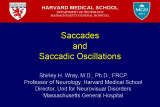 | Saccades (Guest Lecture) | Shirley H. Wray, MD, PhD, FRCP | The video of the normal eye movement examination was made with the assistance of Dr. Terrence Millette, a neurologist and former Fellow with me in 1985-1986. Introduction to the Saccadic System Saccades are fast eye movements that bring the image of an object of interest onto the fovea. They consist... | Normal Eye Movements; Examination, Ocular; Saccades; Optokinetic Nystagmus Drum (OKN Drum); Pursuit; Ocular Motility |
| 5 |
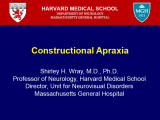 | Constructional Apraxia | Shirley H. Wray, MD, PhD, FRCP | The patient is a 72 year old right handed woman who presented in November 1995 with the sudden onset of impaired coordination of visual and motor skills following an inner right ear infection. One of her problems was difficulty sitting on a chair as she tended to place her body incorrectly. By late ... | Dressing Apraxia; Apraxia of the Left Hand; Constructional Apraxia; Right Parietal Lobe; Progressive Lobar Atrophy; Degenerative CNS Disease; Apraxia |
| 6 |
 | Functional MRI | Devin D. Mackay, MD | Explanation of using functional MRI in examinations. | Functional MRI |
| 7 |
 | Dual Visual Field Defect (Quadrantanopia and Central Scotoma) Unmasks the Hidden Brain Lesion in a Patient with Non-arteritic Ischemic Optic Neuropathy | A. Mohan Kannam; B. Rajat Kapoor; C. Ramesh Kekunnaya, FRCS; Virender Sachdeva, MS, DNB | This submission is an interesting case that highlights the co-existence of two different visual field defects in the same patient presenting to us with clinical picture of non arteritic ischemic optic neuropathy. The correct interpretation of the visual field defects led to the appropriate localizat... | Hemianopia; Central Field Defect; Non-Arteritic Ischemic Optic Neuropathy; Ischemic Infarct |
| 8 |
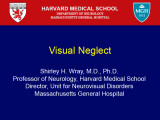 | Visual Neglect | Shirley H. Wray, MD, PhD, FRCP | The patient following infarction of the non-dominant right parietal lobe has visual hemi-neglect on the left. Review: (ref 2) Patient's with hemi-neglect ignore or fail to attend to stimuli on the side of space contralateral to their lesion. Neglect can be multimodal in that all stimuli whether audi... | Impaired Initiation of Horizontal Saccades to the Left; Deviation of the Eyes to the Left Under Closed Eyelids; Normal Pursuit Eye Movements; Parietal Lobe Infarct; Visual Neglect |
| 9 |
 | Clinical Visual Electrophysiology | Gregory P. Van Stavern, MD; Byron Lam, MD | A description of the use of electrophysiology to examine the visual system. | Electrophysiology; Visual Exam |
| 10 |
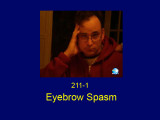 | Eyebrow Spasm (Guest Lecture) | Shirley H. Wray, MD, PhD, FRCP | This case is published courtesy of Daniel J. Costello, M.D., Department of Neurology, Massachusetts General Hospital, Boston. The patient is a 32-year-old right-handed man with an established diagnosis of Tuberous Sclerosis Complex characterized by: -medically intractable epilepsy -developmental del... | Rhythmic Eyebrow Spasm; Torsional Nystagmus; Primary Position Left Beating Nystagmus; Epileptic Seizures; Tuberous Sclerosis Complex (TSC-2 DNA sequence variant); Bipolar Affective Disorder |
| 11 |
 | Screening Battery for Higher Order Visual Dysfunction Due to Neurodegenerative Disease | Victoria Pelak | Awareness that neurodegenerative disease (NDD) can cause visual brain dysfunction is critical for early detection and proper diagnosis. However, awareness must be combined with knowledge about visual brain pathways and clinical assessment tools that can be used to identify cerebral visual dysfunctio... | Alzheimer's Disease; Dementia with Lewy Bodies; Eye Clinic Rapid Screening Battery For Visual Cortical Dysfunction; Posterior Cortical Atrophy; Visual Cortical Dysfunction |
| 12 |
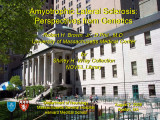 | Amyotrophic Lateral Sclerosis (Guest Lecture) | John Q. Trojanowski, MD | The patient is a 68 year old right handed retired air conditioner repair man who presented with impaired balance and slow walking. For about one year he had noted difficulty lifting his feet high enough when climbing the stairs. From that time on, his movements slowed and worsened so that he had dif... | Saccadic Initiation Deficit of Unilateral Horizontal Gaze; Complete Paralysis of Voluntary Horizontal Saccades on Command to Look Left; Inability to Make a Refixation Saccade on Command to a Target Held on the Left; Normal Voluntary Horizontal Saccadic Eye Movements to the Right; Impaired Pursuit; F... |
| 13 |
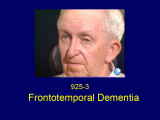 | Frontotemporal Dementia | Shirley H. Wray, MD, PhD, FRCP | The patient is a 68 year old right handed retired air conditioner repair man who presented with impaired balance and slow walking. For about one year he had noted difficulty lifting his feet high enough when climbing the stairs. From that time on, his movements slowed and worsened so that he had dif... | Saccadic Initiation Deficit of Unilateral Horizontal Gaze; Complete Paralysis of Voluntary Horizontal Saccades on Command to Look Left; Inability to Make a Refixation Saccade on Command to a Target Held on the Left; Normal Voluntary Horizontal Saccadic Eye Movements to the Right; Impaired Pursuit; F... |
| 14 |
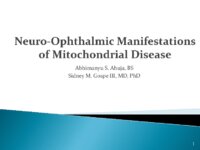 | Neuro-Ophthalmic Manifestations of Mitochondrial Disease | Abhimanyu S. Ahuja, BS; Sidney M. Gospe III, MD, PhD | Classically, mitochondrial diseases exhibit a maternal inheritance pattern because pathogenic mutations in mitochondrial DNA (mtDNA) are transmitted exclusively via the maternal lineage due to rapid degradation of sperm-derived mitochondria early in embryogenesis. However, mutations in mtDNA may occ... | Mitochondrial Disease; Pathophysiology |
| 15 |
 | Confrontation Visual Fields - A Concise Guide for Ophthalmology and Neurology Trainees | Stephen C. Pollock, MD | The guide describes the techniques required to competently perform confrontation visual fields. It outlines a basic screening protocol and discusses methods for further defining defects identified during the screening process. A mini-atlas of visual field defects is included as an appendix. | Confrontation Visual Fields; Visual Field Testing; Perimetry; Visual Field Loss; Visual Field Defect; Ocular Examination; Visual Sensory Evaluation; Neurologic Examination |
| 16 |
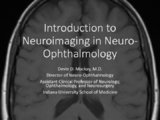 | Introduction to Neuroimaging in Neuro-Ophthalmology | Devin D. Mackay, MD | Introduction to the subject of neuroimaging in the field of neuro-ophthalmology. | Imaging |
| 17 |
 | Treatment Outcomes of Ocular Manifestations in Wernicke's Encephalopathy: Images | Whitney Stuard Sambhariya PhD; Melanie Truong-Le, DO, OD | The case of a 28- year-old woman with a past medical history of gastric sleeve who was reported to have blurry vision and presented to neuro-ophthalmology with double vision. On examination the patient had bilateral abducens palsy, alternating upbeat and downbeat nystagmus with a torsional component... | Wernicke's Encephalopathy; Ocular manifestations; Neuro-ophthalmology; Sbducens palsy; Nystagmus; Double vision; Blurry vision |
| 18 |
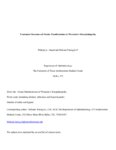 | Treatment Outcomes of Ocular Manifestations in Wernicke's Encephalopathy: Case Report | Whitney Stuard Sambhariya, PhD, Medical Student; Melanie Truong-Le, DO, OD | The case of a 28- year-old woman with a past medical history of gastric sleeve who was reported to have blurry vision and presented to neuro-ophthalmology with double vision. On examination the patient had bilateral abducens palsy, alternating upbeat and downbeat nystagmus with a torsional component... | Wernicke's Encephalopathy; Ocular Manifestations; Neuro-ophthalmology; Abducens Palsy; Nystagmus; Double Vision; Blurry Vision |
| 19 |
 | Progressive Supranuclear Palsy | NANOS | Progressive Supranuclear Palsy (PSP) is a rare progressive neurodegenerative disorder that affects certain parts of the brain, resulting in difficulty with balance, walking, swallowing, and vision. | Progressive Supranuclear Palsy; Patient Brochure |
| 20 |
 | Non-accidental Eye Injuries in Pediatric Patients for the Neuro-ophthalmologist | Rachelle Srinivas; Melanie Truong-Le | Physical abuse, or non-accidental trauma (NAT), remains a leading cause of injury and death among young children, with abusive head trauma (AHT) being a major contributor. Common associated ocular findings include retinal hemorrhages (RH), subconjunctival hemorrhage, and optic nerve abnormalities, w... | Abusive Head Trauma; Child Abuse; Eye Injury; Retinal Hemorrhage |
1 - 25 of 20
